Python实现APP UI自动化以及OpenCV图像识别元素
Python实现APP UI自动化以及OpenCV图像识别元素
·
OpenCV图像识别元素代码
# -*- encoding=utf-8 -*-
__author__ = 'Jeff.xie'
import cv2
import sys
def _tran_canny(image):
"""消除噪声"""
image = cv2.GaussianBlur(image, (3, 3), 0)
return cv2.Canny(image, 50, 150)
def get_center_location(img_slider_path,image_background_path,x_percent,y_percent):
# java传递过来的参数都是str类型,所以需要强转成int类型
xper = int(x_percent)
yper = int(y_percent)
# # 参数0是灰度模式
image = cv2.imread(img_slider_path, 0)
template = cv2.imread(image_background_path, 0)
# 寻找最佳匹配
res = cv2.matchTemplate(_tran_canny(image), _tran_canny(template), cv2.TM_CCOEFF_NORMED)
# 最小值,最大值,并得到最小值, 最大值的索引
min_val, max_val, min_loc, max_loc = cv2.minMaxLoc(res)
#获得背景图像高和宽
src_img = cv2.imread(image_background_path,cv2.IMREAD_GRAYSCALE)
h,w = src_img.shape
#获得需要寻找图像高和宽
des_img = cv2.imread(img_slider_path,cv2.IMREAD_GRAYSCALE)
des_img_h,des_img_w = des_img.shape
trows,tcols = image.shape[:2] #获得图片的宽度,两种方式都可以
top_left = max_loc[0] # 横坐标
# 展示圈出来的区域
x, y = max_loc
# max_loc获取x,y位置坐标,
xLocation = x + int(des_img_w*xper/100)
yLocation = y + int(des_img_h*yper/100)
print("xLocation: "+str(xLocation))
print("yLocation: "+str(yLocation))
return xLocation,yLocation
def get_location_percent(img_slider_path,image_background_path,x_percent,y_percent):
# java传递过来的参数都是str类型,所以需要强转成int类型
xper = int(x_percent)
yper = int(y_percent)
# # 参数0是灰度模式
image = cv2.imread(img_slider_path, 0)
template = cv2.imread(image_background_path, 0)
# 寻找最佳匹配
res = cv2.matchTemplate(_tran_canny(image), _tran_canny(template), cv2.TM_CCOEFF_NORMED)
# 最小值,最大值,并得到最小值, 最大值的索引
min_val, max_val, min_loc, max_loc = cv2.minMaxLoc(res)
#获得背景图像高和宽
src_img = cv2.imread(image_background_path,cv2.IMREAD_GRAYSCALE)
h,w = src_img.shape
print(h)
print(w)
#获得需要寻找图像高和宽
des_img = cv2.imread(img_slider_path,cv2.IMREAD_GRAYSCALE)
des_img_h,des_img_w = des_img.shape
trows,tcols = image.shape[:2] #获得图片的宽度,两种方式都可以
top_left = max_loc[0] # 横坐标
# 展示圈出来的区域
x, y = max_loc
# max_loc获取x,y位置坐标,
xLocation = x + int(des_img_w*xper/100)
yLocation = y + int(des_img_h*yper/100)
x_loc_percent= int(xLocation*100/w)
y_loc_percent= int(yLocation*100/h)
print("x_loc_percent: "+str(x_loc_percent))
print("y_loc_percent: "+str(y_loc_percent))
return x_loc_percent,y_loc_percent
OpenCV图像识别元素代码第二种方法
# -*- encoding=utf-8 -*-
__author__ = 'Jeff.xie'
import cv2
import sys
def get_location_percent(img_slider_path, image_background_path, x_percent, y_percent):
xper = int(x_percent)
yper = int(y_percent)
img1=cv2.imread(image_background_path) #大图
img2=cv2.imread(img_slider_path)
#使用SIFT算法获取图像特征的关键点和描述符
sift=cv2.xfeatures2d.SIFT_create()
kp1,des1=sift.detectAndCompute(img1,None)
kp2,des2=sift.detectAndCompute(img2,None)
#定义FLANN匹配器
indexParams=dict(algorithm=0,trees=10)
searchParams=dict(checks=50)
flann=cv2.FlannBasedMatcher(indexParams,searchParams)
#使用KNN算法实现图像匹配,并对匹配结果排序
matches=flann.knnMatch(des1,des2,k=2)
matches=sorted(matches,key=lambda x:x[0].distance)
#去除错误匹配,0.5是系数,系数大小不同,匹配的结果页不同
goodMatches=[]
for m,n in matches:
if m.distance<0.5*n.distance:
goodMatches.append(m)
#获取某个点的坐标位置
#index是获取匹配结果的中位数
index=int(len(goodMatches)/2)
#queryIdx是目标图像的描述符索引
x,y=kp1[goodMatches[0].queryIdx].pt #获取小图片中心点
#将坐标位置勾画在2.png图片上,并显示
print(x)
print(y)
src_img = cv2.imread(image_background_path,cv2.IMREAD_GRAYSCALE)
height,width = src_img.shape
# print("width:",width)
# print("height:",height)
des_img = cv2.imread(img_slider_path,cv2.IMREAD_GRAYSCALE)
des_height,des_width = des_img.shape
# print("des_width:",des_width)
# print("des_height:",des_height)
x1 = int(x-des_width/2)
y1 = int(y-des_height/2)
x2 = int(x+des_width/2)
y2 = int(y+des_height/2)
click_x = x1+des_width*(xper/100)
click_y = y1+des_width*(yper/100)
# print("click_x",click_x)
# print("click_y",click_y)
x_loc_percent = int(click_x/width*100)
y_loc_percent = int(click_y/height*100)
print("x_loc_percent: "+str(x_loc_percent))
print("y_loc_percent: "+str(y_loc_percent))
return x_loc_percent,y_loc_percent
Python实现APP UI自动化Demo
__author__ = 'Jeff.xie'
# coding:utf-8
from time import sleep
from appium import webdriver
from selenium.webdriver.support.ui import WebDriverWait
from myopencv.get_location_by_opencv2 import get_location_percent
def click_by_location(driver,xper,yper,width,height):
x = int(xper*width/100)
y = int(yper*height/100)
print("x: ",x)
print("y: ",y)
driver.tap([(x,y)],1000)
def click_picture(driver,picture):
current_page=r"D:/current_page.png"
driver.get_screenshot_as_file(current_page)
xper,yper= get_location_percent(picture,current_page,50,50)
print(xper)
print(yper)
sleep(1)
width = driver.get_window_size()['width']
height = driver.get_window_size()['height']
click_by_location(driver,xper,yper,width,height)
#获得机器屏幕大小x,y
def getSize(driver):
x = driver.get_window_size()['width']
y = driver.get_window_size()['height']
return (x, y)
#屏幕向上滑动
def swipeUp(driver,duration): # duration 滑动时间(默认5毫秒);
l = getSize(driver)
x1 = int(l[0] * 0.5) #x坐标
y1 = int(l[1] * 0.75) #起始y坐标
y2 = int(l[1] * 0.25) #终点y坐标
driver.swipe(x1, y1, x1, y2,duration)
#需要打开Appium桌面端
desired_caps = {}
desired_caps['platformName'] = 'Android'
desired_caps['platformVersion'] = '10'
desired_caps['deviceName'] = 'emulator-5554'
desired_caps['appPackage'] = 'com.android.settings'
desired_caps['appActivity'] = 'com.android.settings.Settings'
desired_caps["resetKeyboard"] = "True"
desired_caps["noReset"] = "True"
driver = webdriver.Remote("http://127.0.0.1:4723/wd/hub",desired_caps)
WebDriverWait(driver,60)
sleep(2)
sleep(10)
driver.update_settings({"getMatchedImageResult": True})
click_picture(driver,"WIFI1.png")
sleep(3)
sleep(5)
if __name__ == '__main__':
pass
更多推荐
 已为社区贡献23条内容
已为社区贡献23条内容









所有评论(0)